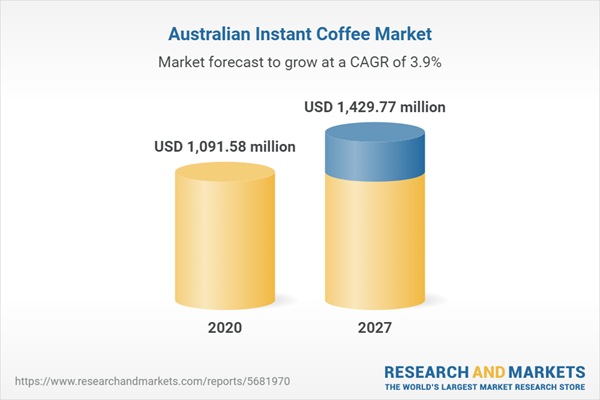The market for instant coffee is projected to grow at a steady pace in the forecast period as coffee is one of the preferred beverages among the citizens of the country. It has been observed that a substantial number of people in Australia prefer coffee every single day. Hence, the market holds strong prospects for growth with the prevalence of coffee consumers in the country. Furthermore, the consumers’ willingness to spend on coffee is driving the market demand during the forecast period. It has been observed that more than 4 in 5 Australians spend money on coffee in an average week, indicating that Australia has a well-established coffee culture.
The growing popularity of coffee among the younger generation of Australia is further augmenting the market demand in the forecast period.
Talking in terms of preferences, instant coffee is preferred equally to espresso coffee. However, it is preferred more among the older generations, hence, contributing to surging market growth over the next five years.The high prevalence of coffee drinking in households will continue to soar the market demand in the forecast period. Instant coffee holds a higher share in households compared to cafes. On the other hand, the younger generation of the country prefers drinking coffee at cafés and restaurants. This will further enhance the market growth among these end-users. Additionally, in Australia, one can see more independent cafés rather than the prevalence of coffee chains. There are more than 90% independent coffee houses or cafes in the country.
Keeping in view the current COVID-19 scenario, the market is projected to decline with the shutting down of coffee shops and restaurants owing to lockdown and self-quarantine measures in 2020. After recovery, i.e., post-lockdown, the market is further poised to experience steady growth by the end of 2025 along with workplace safety measures which include practising social distancing.
Significant strategic initiatives in the form of partnerships and collaboration will propel the market growth in the forecast period.
The coffee alliance or partnership between Starbucks and Nestle in 2018 predicted that the development of new products under the coffee alliance would help in increasing sales around the world. This included coffee sales in Australia as well. In May 2018, Nestle achieved the rights to sell Starbucks packaged coffee products, and the transaction was completed in USD7.15 billion, allowing Starbucks to focus on its cafe business. The collaboration was projected to help Nestle in tackling tough competition in the coffee market from its rivals. Starbucks is aiming for a higher market share. For this, Nestle developed a range of novel products, which included Starbucks-branded capsules, among other products, and made them available to over 40 markets by the end of 2019. Also, the company stated that it was introducing Starbucks premium soluble coffee at the global level; it further stated that the soluble coffee is growing at a fast pace in China. However, in Japan, Australia, Malaysia, Singapore, and the UK, where the popularity of soluble coffee is higher, the products should perform well.It is projected that the type of freeze-dried instant coffee will dominate the market.
The superior quality of freeze-dried coffee in comparison to regular coffee is the main element fueling the industry's expansion. As a result of the media's growing influence, particularly the various e-Commerce platforms, educational healthiness programs, events, and publications by international health administrations like the World Health Organization, there has been an increase in consumer awareness of wellness and health throughout the world. The most popular application for freeze-dried coffee is in travel pouches for coffee lovers. The preparation is quick, straightforward, and easy. Additionally, these freeze-dried ready-to-drink coffees are offered in a variety of packaging options, mostly in the form of bottles, cans, and tetra packs that come in a range of volumes and pack sizes to suit the requirements of varied customers.Recent Developments and expansions
Nestlé announced the global release of Starbucks premium instant coffee in February 2020. The new line includes tea lattes, a variety of coffee drinks, and coffees in both medium and dark roasts. The products, which come in single-serve and multi-serve tin forms, combine Starbucks' distinctive premium taste with Nestlé's unmatched knowledge and heritage in the instant coffee market.A speciality instant coffee that combines quality, flavour, & convenience in a single sachet was introduced in March 2022 by Melbourne coffee roaster Beat Coffee. The vitality of the coffee may be instantly preserved through the freeze-drying process, preserving the notes of caramel and honey.
COVID-19 Impact
Due to the country's restaurant and coffee shop closures, a modest fall in the instant coffee market is anticipated. Disruptions in the supply chain also hampered market expansion. However, it is projected that the market would recover due to the present trend of online shopping for consumption at home.Segmentation:
By Type
- Freeze-Dried Instant Coffee
- Spray-Dried Instant Coffee
By Distribution Channel
- Offline
- Retail
- Food Services
- Online
By Province
- New South Wales
- Queensland
- Victoria
Table of Contents
Companies Mentioned
- Nestle
- Cofi-Com Trading Pty Ltd.
- FreshFood
- JACOBS DOUWE EGBERTS
- Aldi Stores Limited
Table Information
| Report Attribute | Details |
|---|---|
| No. of Pages | 81 |
| Published | September 2022 |
| Forecast Period | 2020 - 2027 |
| Estimated Market Value ( USD | $ 1091.58 million |
| Forecasted Market Value ( USD | $ 1429.77 million |
| Compound Annual Growth Rate | 3.9% |
| Regions Covered | Australia |
| No. of Companies Mentioned | 5 |









